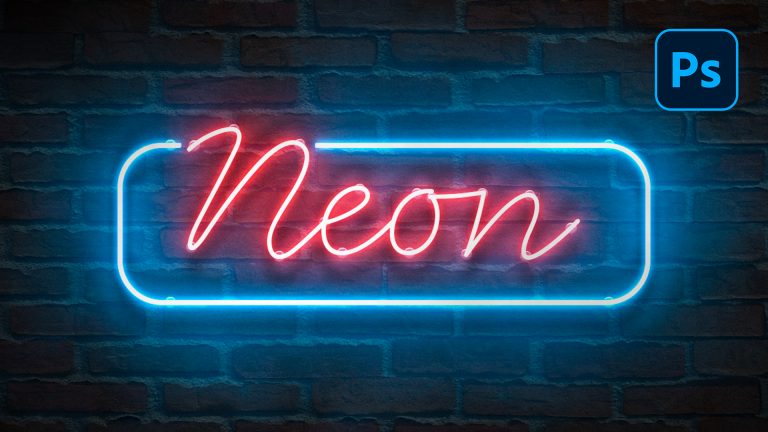Illuminating Creativity: A Comprehensive Guide to Crafting Realistic Neon Light Effects in Photoshop

Introduction:
Neon lights have an unmistakable allure, casting a vibrant and captivating glow that adds a touch of urban chic to any design. While capturing the magic of real neon lights may seem challenging, Adobe Photoshop provides a versatile platform for artists and designers to replicate this effect with precision. In this extensive guide, we will unravel the step-by-step process of creating a realistic neon light effect in Photoshop, empowering you to infuse your digital art, graphics, or photographs with the electrifying charm of neon illumination.
1. Understanding the Essence of Neon Lights:
Before delving into the tutorial, it’s essential to grasp the characteristics that define neon lights. Neon lights exhibit a vivid, glowing quality with distinct features such as bright colors, a characteristic glow, and a tube-like appearance. Replicating these elements in Photoshop requires a thoughtful combination of layer styles, blending modes, and strategic adjustments.
2. Setting the Stage: Creating a Dark Background:
Begin by opening your desired image in Photoshop or creating a new canvas. For the neon light effect to stand out, a dark background is crucial. Adjust the canvas color or use a gradient to create a dramatic, nighttime ambiance.
3. Creating the Neon Light Path:
Using the Pen Tool, trace the path where you want the neon light to appear. This path will serve as the foundation for your neon design. Experiment with curves, loops, or straight lines based on your creative vision.
4. Applying the Neon Glow: Layer Styles and Blending Modes:
Select the path you created, and with the Brush Tool, apply a vibrant color using a soft brush along the path. Then, apply layer styles such as Outer Glow and Inner Glow to simulate the characteristic neon illumination. Experiment with the opacity, size, and color of the glow until you achieve the desired intensity.
5. Creating the Neon Tube: Outer Stroke Effect:
To give the neon light a defined tube-like appearance, duplicate the path layer and remove layer styles from the duplicate. Apply a stroke effect using the Layer Style options, adjusting the size to create the tube thickness. Set the stroke color to a complementary shade to enhance the neon’s realism.
6. Adding Realistic Illumination: Adjustment Layers:
Introduce adjustment layers like Levels, Curves, or Color Balance to enhance the overall illumination and color consistency of the neon light. Adjust the contrast, brightness, and color tones to achieve a seamless integration with the background and surrounding elements.
7. Creating Neon Reflections: Adding Glow on Surfaces:
For a realistic touch, consider adding reflections or glows on nearby surfaces. Duplicate the neon light path layer, adjust the color to a lighter shade, and position it strategically to simulate reflections. Experiment with the opacity and blending modes for a subtle, authentic glow effect.
8. Distortions and Flickering Effects: Filter Techniques:
To mimic the organic nature of neon lights, apply distortions or flickering effects. Utilize filters like Gaussian Blur, Radial Blur, or Liquify to introduce subtle variations and imperfections, creating an authentic and dynamic neon glow.
9. Creating Additional Neon Elements: Text and Shapes:
Extend your neon composition by incorporating text or additional shapes. Apply the same layer styles and blending modes to maintain consistency with the primary neon light. Experiment with different fonts and styles to customize the text and enhance the overall visual impact.
10. Fine-Tuning and Refinement: Detail Matters:
Zoom in to scrutinize the details of your neon light effect. Fine-tune the layer styles, adjust the curves of the neon path, and refine any inconsistencies. Pay attention to the overall balance and ensure that the neon illumination seamlessly integrates with the surrounding environment.
Conclusion:
Crafting a realistic neon light effect in Photoshop is a journey that combines artistic vision with technical precision. As you experiment with layer styles, blending modes, and adjustments, remember that attention to detail is key to achieving a convincing and immersive neon glow.
Embrace the versatility of neon lights to enhance your digital art, graphics, or even photographs. Whether you’re creating a futuristic cityscape, a retro-inspired sign, or an electrifying visual composition, the realistic neon light effect in Photoshop offers a vibrant and dynamic element that can elevate your designs to new heights. Let your creativity shine bright as you master the art of replicating neon lights in the digital realm.




